Talking to Ourselves
Wine Media is BROKEN. To Attract New Customers, We Need to Reinvigorate and Empower Wine Writing in Non-Wine Media
“Really knowing is good. Not knowing, or refusing to know, is bad, or amoral, at least. You can't act if you don't know. Acting without knowing takes you right off the cliff.”
― Ray Bradbury, Something Wicked This Way Comes
Make no mistake: The wine industry is at a problematic crossroads. A litany of articles and reports have flooded the media landscape, accurately describing the challenges we face as an industry. Selling wine is no longer a cakewalk. In fact, it’s the hardest it’s been in decades, and it’s only getting harder.
Echoing our bad news was Karen McNeil’s sad-but-true message about the state of wine writing. She has every reason to be concerned; wine media is serious trouble.
How Wine Media Got Broken
One can attribute the decline of media in general to the internet and search engines, which have changed our focus from quality content to the chase for clicks.
You'll see many consumer-facing wine publications posting listicles, the worst being "The Best of <insert wine type/region here> RIGHT NOW" or those with headlines like:
● Can I Ask for a Fresh Pour if There's a Bug in My Glass?
● How to Get Over a Hangover, According to a Medical Pro
● Which Wines Pair with Halloween Candy?
● Wine Horoscopes
Equally challenging and simultaneously liberating was the birth of online self-publishing tools like WordPress, Blogger, MoveableType, Medium, and Substack. They created a new wave of wine content and accessibility while delivering tsunamis of free content. How does one compete with free?
You Get What You Paid For
To compete with free, these tools also spawned a wave of publications asking for unpaid contributions or pay based on article performance, further perpetuating the clickbait. For example, most Forbes "contributors" were originally unpaid bloggers and only financially rewarded based on traffic (this policy has slightly changed, with most contributors guaranteed $250/month if they meet some minimum conditions). While I am a giant advocate of blogging (and some ethical Forbes Contributors), the illusion that these writers are under any editorial oversight or even applying ethical journalistic standards while using the Forbes masthead to give the veneer of authority is a terrible injustice for consumers and media in general.
The trend has also led consumers to balk at the very idea of having to pay for content. As a point of reference, whenever I share article links from the local Napa Register or SF Chronicle, one of the first comments I regularly get is, "Paywall, do you have a free version?"
Social Media’s Impact
Social media's transformational nature has changed how we interact with media. Most of our content consumption echoes the usage and size of social media posts, which are much smaller than traditional content or often in different formats like pictures or short videos (e.g., Instagram, TikTok).
Consumers have been forced into a new reality of micro attention spans, forcing traditional writers to consider building “snackable content” or find ways to present critical excerpts for social media distribution and consumption.
Despite all these challenges, we have an incredible stable of writers who dedicate their time to wine. Eric Asimov, Alder Yarrow,
, Karen McNeil, Dave McIntyre, Robert Joseph, Sara Schnieder, , Matt Walls, Julia Coney, David Brown, Tina Caputo, Lisa Perroti Brown MW, Rebecca Gibb MW, Sean Sullivan, , L.M. Archer, Elisabetta Tosi, Anthony Giglio, Devin Parr, Adam Lechmere, Kelli White, Guy Woodward, Elin McCoy, Clare Tooley, Jason Miller, Tšepang Molisana, Samantha Cole-Johnson, Jeff Siegel, , Tim Fish, Malu Lambert, Anne Krebiehl MW, Jill Barth, Christina Picard, Allison Levine, Oz Clarke, Amanda Barnes, Joe Fattorini, Dorothy Gaiter, Andrew Jefford, Elin McCoy, Mike DeSimone, Jeff Jenssen, Kathleen Wilcox, Jane Anson, , Katherine Cole, Kathleen Willcox, Wink Lorch, Patrick Comiskey, Ray Isle, Joe Roberts, Lenn Thompson, Randy Caparoso, and soooo many more. We have incredible experts who have spent their lives understanding regions, styles, and grapes (e.g. Elizabeth Gabay MW, Peter Liem, and more) that should be elevated and celebrated. Here’s a great list of them on Twitter.We also have an extensive, unique, specialized array of wine writers whose primary job is to rate and critique wine, like James Suckling, Joe Czerwinski, Neal Martin, Tim Atkin, Tim Fish, Jeb Dunnick, Antonio Galloni, Stephen Tanzer, James Laube, Thomas Matthews, Bruce Sanderson, and James Molesworth. As Robert Joseph shared - it is a very challenging vocation.
However, there is also a crew of, mostly old white guys or young natural wine fanatics, whose sole job is to promote the wines they enjoy drinking and denigrate all other wines as being inauthentic, from “Big Wine,” from what they deem as boring regions like Napa, Sonoma, Bordeaux, Melbourne, etc., or they consider dull grapes like chardonnay, merlot of cabernet. They build and perpetuate a wine culture around gatekeeping. Since most have never operated a wine business, they have lazy and often harmful takes on the industry.
Interest in Wine-Only Publications is Niche
Despite the cornucopia of stories about wine, interest in subscribing to wine-only content is niche. Most wine-only sites have less than 20K paying subscribers AND even fewer MAUs (monthly active users). Only the elite publications and content providers that are both digital and physical have more. Most are combinations of stories and reviews.
While traffic is not a meaningful measurement of true readership, it is indicative of a site's total addressable audience.
While some of these numbers may be low in total subscribers and MAUs, it can be reasonably argued that their job is not to serve general consumers but to influence the 11+% of the population that influences the rest of the wine drinkers.
You can see the ripples of their influence when you map the publications against the audiences that read them regularly.
Despite their size, these smaller publications carry a unique and significant value when measured over time, a fact that we should all appreciate and acknowledge but never mistake for direct consumer impact.
Creating and distributing content is a costly endeavor. Even if you pay decent rates and have a proper editorial infrastructure, you need meaningful subscriptions, advertising, or some NEW model to finance it.
Unfortunately, as I mentioned before, modern consumers are conditioned to understand that content is free, and the challenge to get consumers to pay in, as Alder Yarrow so intelligently observes, is “a bull market for free content.” And it’s important to size the addressable market of consumers that will pay a yearly subscription of:
$29.95 - Wine Enthusiast
$21.99 - Food and Wine
$49.95 - Wine Spectator
$99 - Jeb Dunnuck
$129 - Robert Parker
$129 - Decanter
$134.99 or $189.99 - Jancis Robinson
$140 - Vinous
$145 - Suckling
Competition for subscriber dollars is fierce in the wine publication industry, especially for those subscribing to multiple publications. Ask your wine-interested friends if they would pay $100/year for any wine subscription and see how they respond. As someone who writes for free on Substack, I can only imagine how this number explodes for all the writers working so hard to scratch extra income using this platform and how hard they need to work to earn even $60/year from a wine consumer.
Not to mention, these publications are all competing for many of the same consumers. If you were to subscribe to all of them, just these nine publications alone are over $850 per year. The trade versions of these same subscriptions are more than double that price. Fortunately, for wine review publications, and depending on their value in the market, the trade provides a consistent subscriber base because scores are essential for their sales and marketing efforts.
This often feels like a growing challenge. Wine scores no longer drive large increases in sales, and so many wines are not even reviewed by critics. James Suckling leads the volume of wine tastings - about 40K wines per year. However, that is only a fraction of the nearly 180K new labels released in the U.S. annually, leading to a swath of wines that need top critic reviews.
Wine publications without subscriptions primarily earn revenue from advertising, so they must write about more adult interests than wine: spirits, beer, cannabis, cigars, and more. They need to draw as many viewers (not necessarily readers) as possible to earn higher advertising fees (another thing driving clickbait leads and litanies of listicles). Moreover, they will sell advertising for nearly anything.
With the decline of ad dollars, search tools are deprecating cookies, and social media algorithms are becoming increasingly difficult to influence to aid in content distribution; many of these companies are in more trouble than ever. We've seen this play out within the industry with the wonderful and beloved publication Wine & Spirits and paralleled outside the wine industry with Good Beer Hunting. Founder & Publisher Michael Kiser’s comments reflect two problems: the broken way media is funded and the belief that you can't simultaneously be commercially viable and still produce high-quality content.
"From day one, I vowed to not try and make GBH profitable, because the media world already showed that to achieve profitability was to welcome a certain kind of death—and often a shameful one. Chasing advertisers and clicks with listicles and promotions—and as a result, never creating anything of real value to anyone but the advertisers." - Michael Kiser
Reaching a General Audience
But as I stated, the wine industry has a problem. We are not attracting new consumers, and a big part of the problem is that wine publications often target the same small, already dedicated echelon of consumers.
Some of us remember when nearly every local newspaper and lifestyle publication had wine features. Those days are gone. With the terrible challenges of print media (and now digital), many publishers determined these sections to be irrelevant to their readers and too costly to produce and maintain. As such, we’ve seen a mass culling of wine sections across the U.S.
Today, very, very, very few periodicals or newspapers have a dedicated wine section. And the ones with over 200K subscribers have been reduced to less than ten outlets: NYT, WSJ, SF Chronicle, Food & Wine, Washington Post, Bloomberg, Robb Report, and Men’s Journal. These publications have a challenging job of speaking to a nominally wine-engaged audience while still appealing to oenophiles about wines they can actually buy and experience. Like some mainstream media, a few gravitate towards sensationalism or abuse their ink by writing about their personal passions with little to zero (or Zero Zero) value for actual consumers.
With so few publications or outlets covering wine, a dedicated wine writer requires a lot of hustle to earn a living. I'm fortunate to have so many as friends, and I empathize with the challenge of their journey to make a living. They are always pitching stories, writing them for low pay, and then chasing payment from publications. As a result, it's a second or third job for many talented people. They compete against writers willing to couch surf across the world to live the wine lifestyle or against wealthy hobbyists who write as a means of getting invited on press trips or to attend high-profile tastings for wines they would never buy.
What’s the Solution?
To reiterate, wine media is in trouble because of the broader challenges with media, the size of the audience, and the challenges with creating a sustainable revenue model. And with wine itself now experiencing similar problems of declining interest, therein lies the solution for both. So, how can the industry fix this?
Wine companies need to advertise and support non-wine publications and demand that they create an independent wine section. We see Benovia putting up their cash to support local journalism. We need to see more of this.
The industry must find a pathway back into the daily relevance of society, and the great wine writers need more sustainable ways to earn a living and share the fantastic stories that enrich our magical drink.
Regional associations can also use some of their fees to support independent content creation so that the region's stories can be documented and shared. Virginie Boone and Sonoma Grapegrowers have already created an excellent example. Still, it should not be a dabbling but a full-throated investment in a powerful regional content program. This can also be done by supporting other great local efforts.
For example, Napa Valley Features is the gold standard for stories about Napa. It was built to support locals and is also fantastic for ecotourists or anyone interested in the region.
I leave you with these two great pieces of wine writing to enjoy with a beautiful glass. The first is from Andrew Jefford about wine writing and should be essential reading for every wine writer.
The second is a haunting and appropriate ode to the value of wine from one of the greatest wine writers our industry has ever seen, Eric Asimov.
Cheers.
Next on Transforming Wine - Most Online Wine Club Models Suck

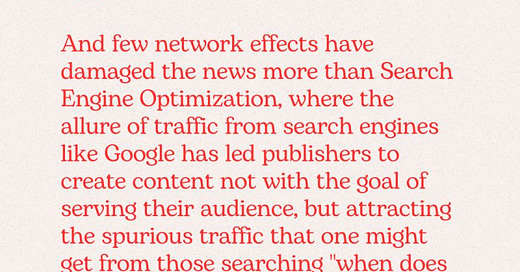



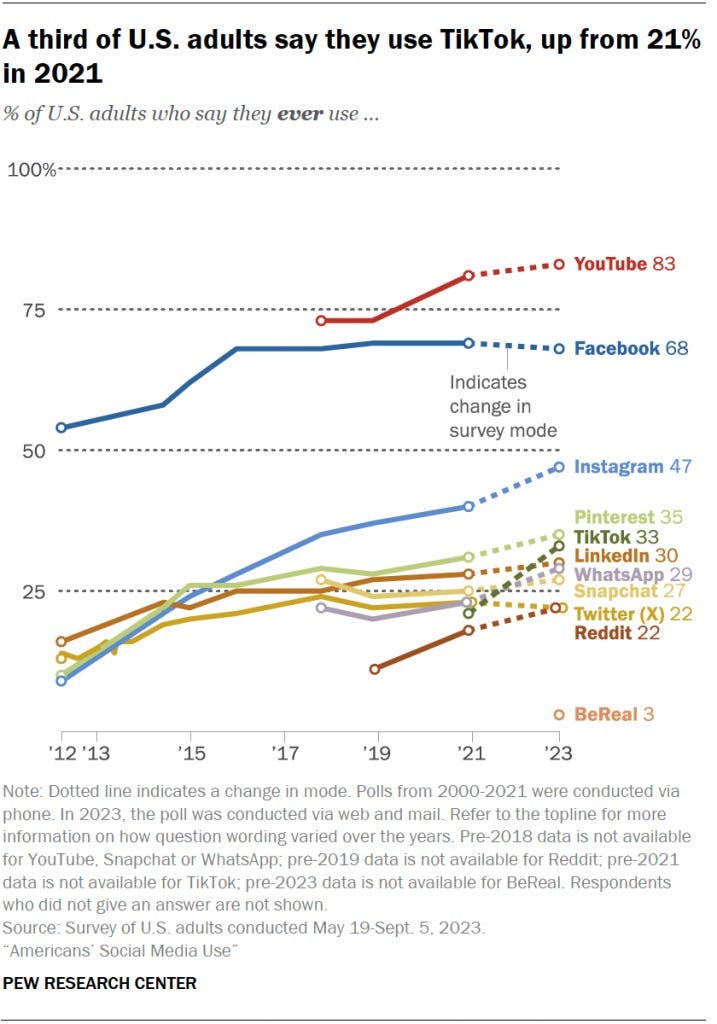

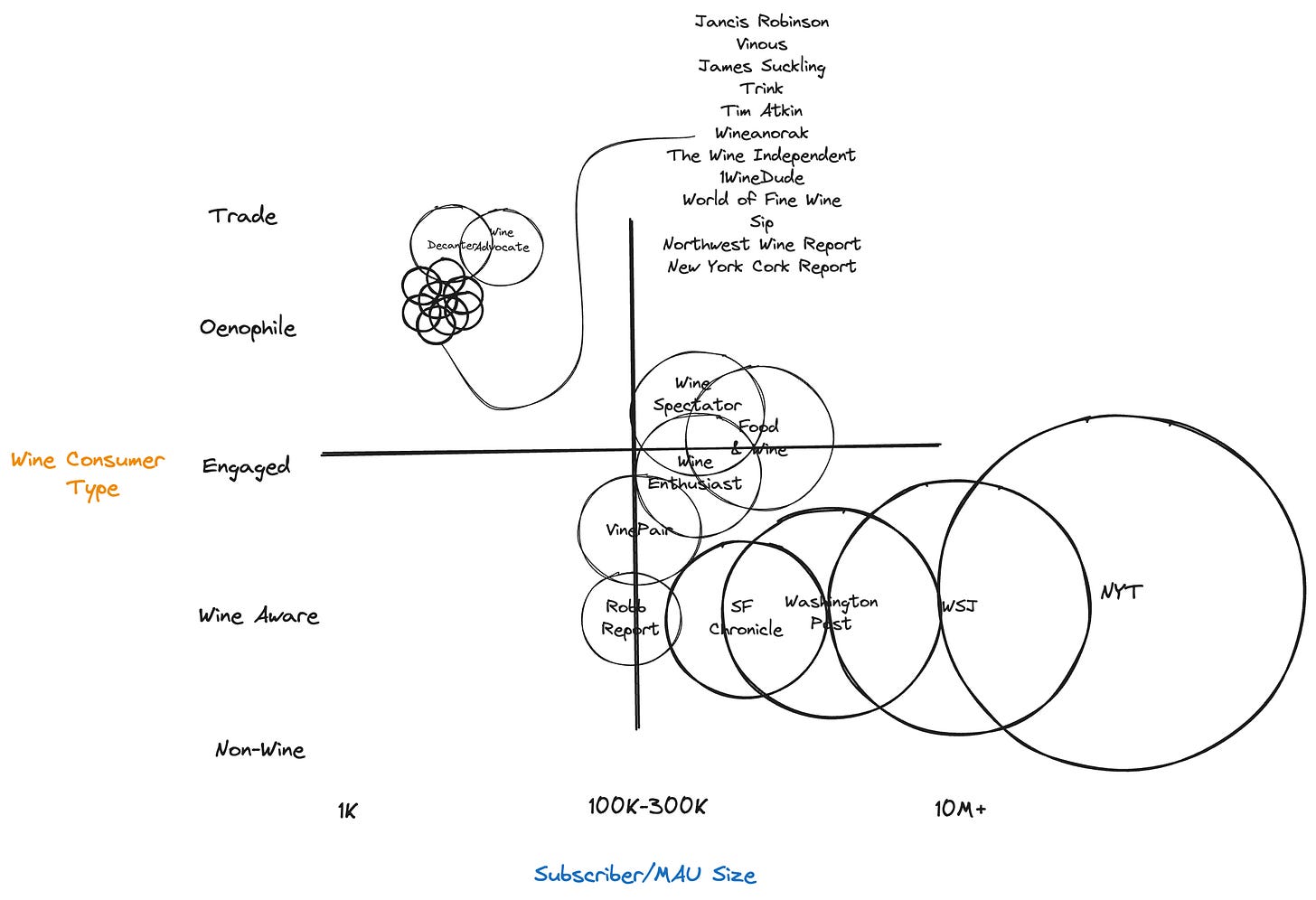


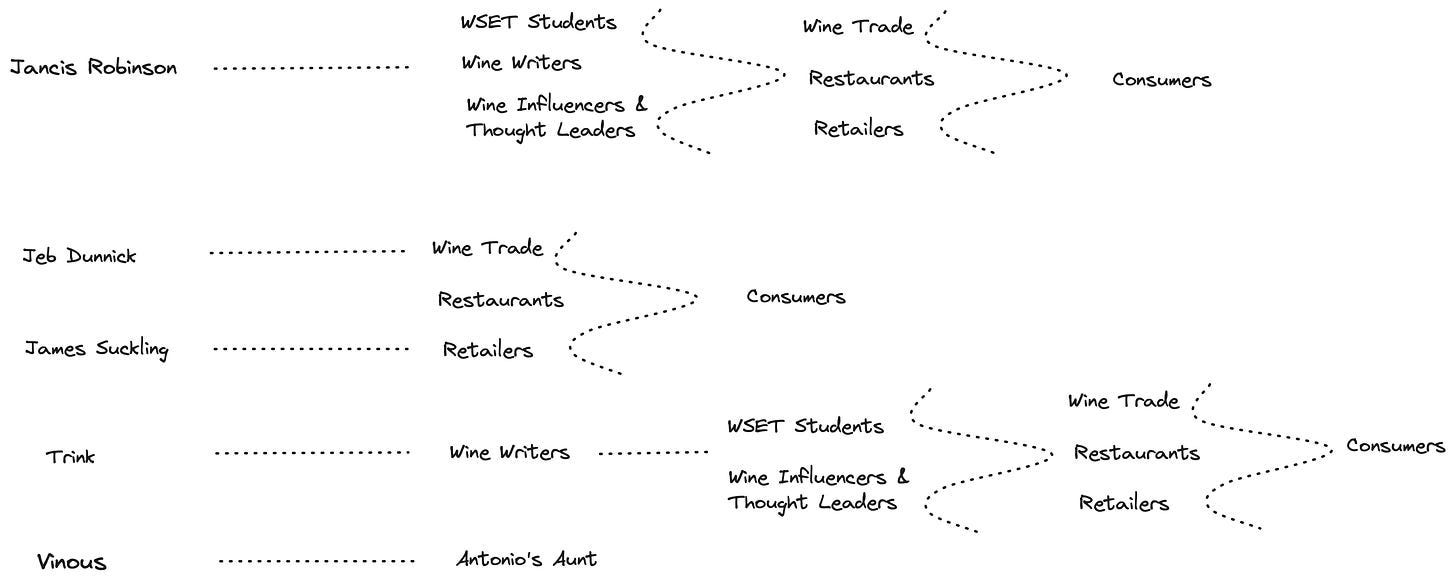

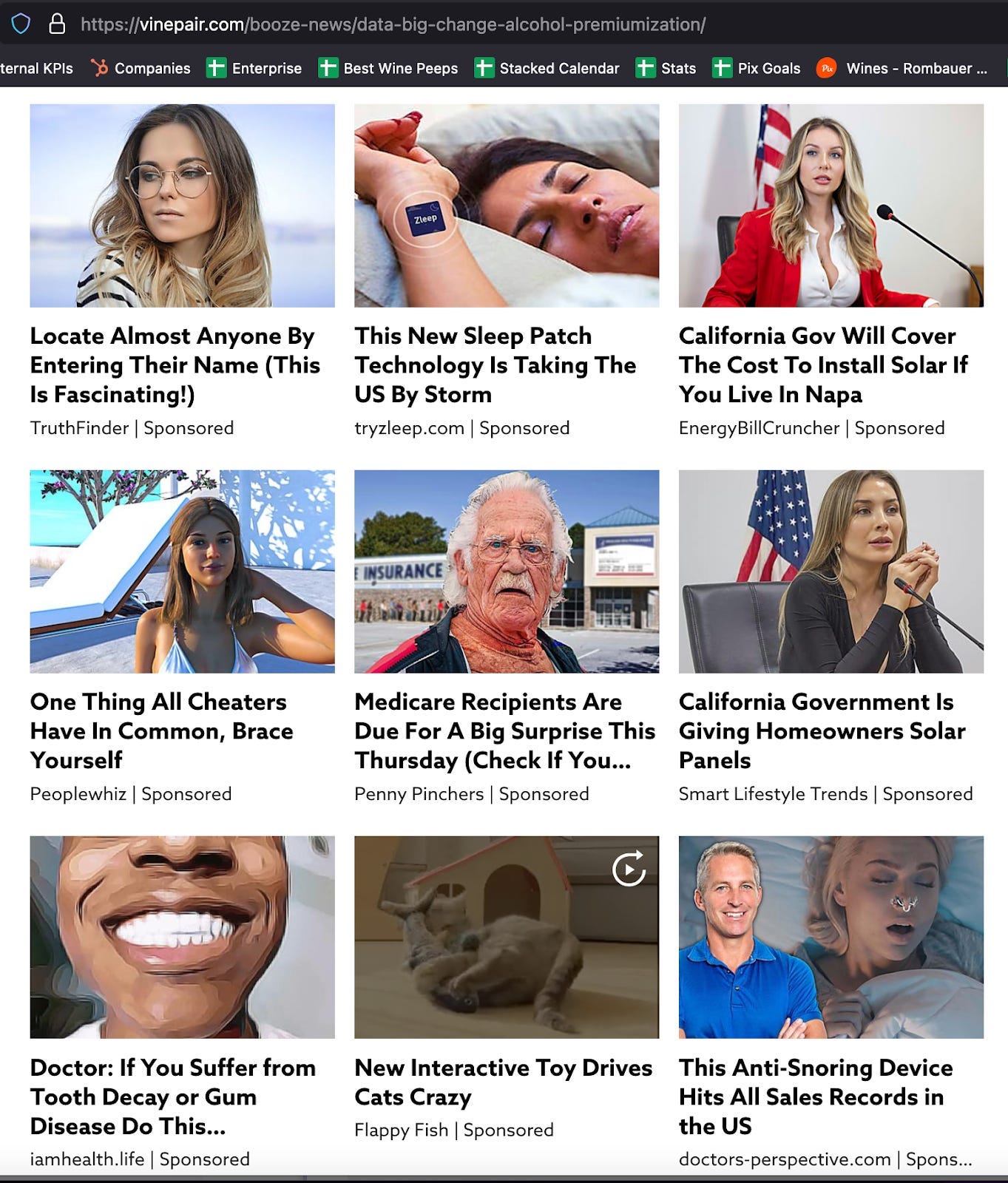
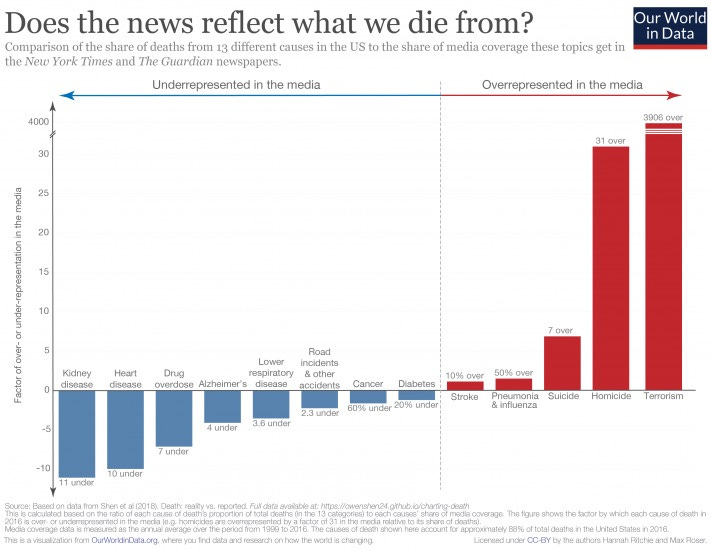
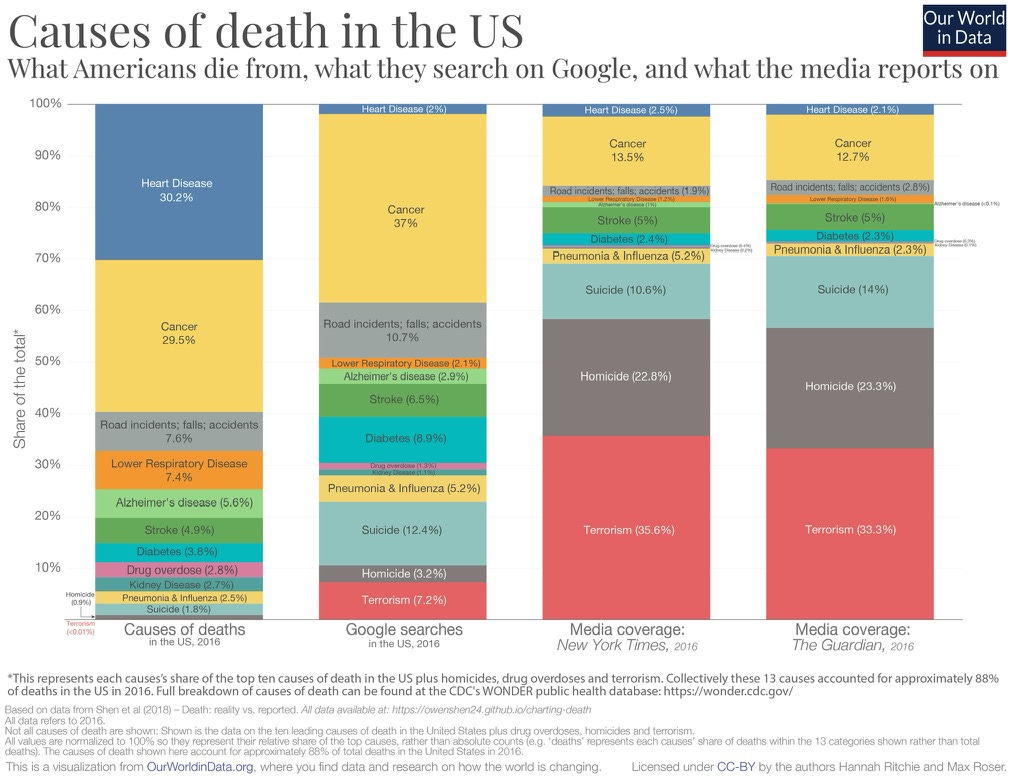
ICYMI - Joe Roberts wrote an amazing companion piece to this article - https://www.1winedude.com/we-told-you-so-wine-medias-day-of-reckoning-is-here-and-can-we-fix-it/?fbclid=IwY2xjawEYlIRleHRuA2FlbQIxMQABHf0bDVVjGnw_6AKVzeiQOB_8M8dxOL9DpeEwkjiw8HM4E-74LxtqE8uQFw_aem_YgtXVtkvKSjI4fVgvjddEQ
Also I wanted to make a correction - Food and Wine has over 900K subscribers. I properly listed it on the chart but not in the content. It's now properly represented.
Finally, I've missed some great wine writers in the article and I'll add more in the notes as I remember them.
As a wine producer I am also concerned about the same topic and I feel that even if I am from the distant Somló mountain, I have come to similar conclusions in many respects.
https://somlo.substack.com/p/valamit-elrontottunk-we-messed-up